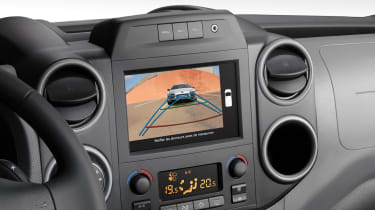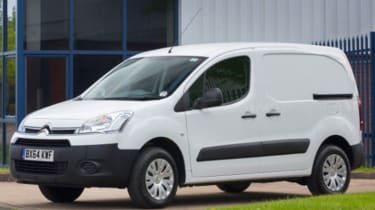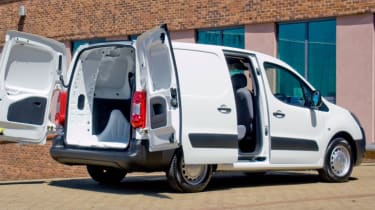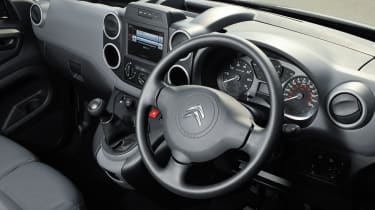Citroen Berlingo (2008-2018) van review
Citroen Berlingo offers a choice of bodystyles and payload options, sat-nav on all models and economical engines
Citroen’s Berlingo has been with us since 2008, although the name dates back to 1996 and the launch of the first generation Berlingo. The second generation, developed alongside the near-identical Peugeot Partner, benefited from a limited 2015 facelift that refreshed its looks and added more advanced Euro6 diesel engines. This improved refinement and fuel economy, but did little to bring the van up to the standard of more modern rivals.
Equipment levels have improved too, especially in Enterprise trim, in an attempt to keep Berlingo in line with competitors such as the Ford Transit Connect, the Volkswagen Caddy and Fiat's Doblo Cargo. In many ways though this is just an attempt to disguise the fact that Berlingo is an aging design.
The Citroen Berlingo is offered in L1 and L2 variants. However unlike others in this class the two vans have different length bodies but an identical wheelbase. This means that the highest potential payload is actually available on the L1, rather than the longer L2 body, which is little more than an extra body section sitting behind the rear axle.
Average Van Insurance Costs
In association with
Citroen Berlingo
| Job Type | City | Out of City |
| Tradesman | £574 | £563 |
| Company Director | £470 | £479 |
| Other | £457 | £641 |
These are indicative prices based on a small volume of policy holders who meet the occupation and location criteria noted with Admiral Van Insurance, your individual price may vary. Based on vehicles aged 2015 or younger and policies sold from 1.7.17 to 31.7.18.
Used - available now

2024 Volkswagen
Golf
25,158 milesManualPetrol1.5L
Cash £16,800
2022 Mercedes
A-Class Saloon
17,937 milesManualPetrol1.3L
Cash £20,600
2021 Audi
A6 Avant
39,141 milesAutomaticPetrol2.0L
Cash £28,800
2022 Mercedes
GLA
28,365 milesAutomaticPetrol1.3L
Cash £21,500Berlingo has a sister model based on the same platform called the Peugeot Partner and the van also forms the base for the versatile Berlingo Multispace MPV. Most UK buyers will choose diesel power and that means the latest Euro6 1.6-litre BlueHDi common-rail injection engines. The good news is that these engines are smoother and quieter for the driver and more economical for the fleet owner.
The Euro6 units use Selective Catalytic Reduction (SCR) technology to dip under the emissions threshold. There's a 75bhp 1.6-litre BlueHDi, a 100hp model and a range-topping 120hp version. The 75hp motor comes with a five-speed manual gearbox while the more powerful engines get a 6-speed manual gearbox. The ETG6 6-speed automated manual transmission is a further option with the 98hp engine, while the 98hp and 120hp models can be had with Start&Stop technology to stretch a gallon of fuel even further.
Berlingo buyers can also choose a 96bhp 1.6-litre VTi petrol engine or an all-electric version, although the petrol version is restricted to the shorter L1 bodystyle.
Trim levels range from the fairly basic X through LX and on to the top-spec Enterprise model, while there’s also an XTR+ version, which promises limited off-road ability with increased ground clearance and a clever electronic traction control system. All Berlingos come reasonably well equipped, with Teletrac Smartnav navigation and Trackstar vehicle tracking across the range. The top spec versions get a neat 7-inch touchscreen for DAB audio control and reversing camera if fitted, but still use the secondary screen for nav functions. Enterprise also comes with air conditioning and reversing sensors.
Inside, Berlingo is impressively versatile, with a range of bulkhead options and seat configurations. There’s also a crew van model, providing seating for up to five people, while a platform van Berlingo allows buyers to add bodywork to suit their needs.
MPG, CO2 and Running Costs
The Citroen Berlingo is one of the most efficient vans in its class. The most economical version is actually the 98bhp BlueHDi 100 with the ETG6 automatic gearbox - it returns 68.9mpg with CO2 emissions of 109g/km. The same engine with the manual gearbox manages 67.3mpg and 111g/km. Every diesel engine in the Berlingo range exceeds the 50mpg mark but the petrol unit only manages 43.5mpg.
Citroen also offers a Berlingo L1 Electric, which claims a range of 106 miles from a 12-hour charge through a domestic power socket. In addition, it has a quick-charging facility that can take the battery from empty to 80 per cent capacity in only 35 minutes.
In 2017, this was joined by a new and larger L2 Electric, which is powered by the same 49kW drivetrain and boasts an identical range to the smaller version. In response to customer feedback, all electric models are now supplied with a 16A Type 2 charging cable, compatible with the majority of public charging points.
Conventional diesel models have service intervals of 12,500 miles and 24 months which are on the short side compared to rivals. However, the Berlingo hits back with some of the lowest insurance groups in the small van market – as with the Peugeot Partner, the line-up ranges from groups 1E to 3E.
The Berlingo Electric is an attractive proposition if you intend to make regular deliveries in London, as electric vans are exempt from the congestion charge. At £11.50 per day, or £10.50 via Auto Pay, the savings will soon mount up. Furthermore, Transport for London will introduce a £10 T-Charge from October 2017, payable by all vehicles which fail to meet the minimum exhaust emission standards. With this in mind, a Citroen Berlingo Electric could make a great deal of sense.
Berlingo Electric customers are also eligible for the Plug-in Van Grant (PiVG) which discounts the price of buying the vehicle. The PiVG covers 20% of the cost of the vehicle (including VAT) and could be worth in excess of £5,000 if used against the price of a new Berlingo Electric L2.
Electric vans are exempt from Vehicle Excise Duty (VED), delivering a saving of £230 per year compared to a conventionally powered van. Citroen also claims that maintenance costs for the Berlingo Electric are 30-40% lower than the diesel or petrol versions. All of a sudden, the starting price of circa £14,000 plus VAT and fees looks a whole lot more appealing.
Load Space and Practicality
Buyers get a choice of bulkhead options with the Citroen Berlingo. A ladder-type arrangement is fitted as standard. This sits behind the passenger seat, allowing owners to take advantage of the Extenso folding seat mechanism included on LX, XTR+ and Enterprise models, and arrange the passenger seat as they want it. A full-height steel bulkhead is available as an option, although Enterprise versions get this as standard.
Citroen also offers a half-height steel bulkhead, with removable panels and a steel mesh upper section. The removable panels work in conjunction with the Extenso seat – which folds flush with the floor – to increase the length of the load bay from 1,800mm to 3,000mm.
If you regularly carry long loads, but don’t require maximum payload, go for the L2 model: fabricated sections extend the overhangs at the rear to free up extra space, although the van looks rather ungainly than the more common Berlingo L1 as a result. Alternatively, if you need to transport more than three people, you should consider the L2 crew van.
It’s fitted with a clever combined rear seat and sliding bulkhead. This means whether you’re using the extra seating capacity or have folded the rear seats flat, a bulkhead is locked in place to separate the load from the passenger compartment. Trouble is, passengers using these seats don’t get a lot of legroom, and when the seats are folded, they limit the amount of adjustment in the driver’s seat.
The load area is longer than in rivals like the Ford Transit Connect and Renault Kangoo, and comparable with the Volkswagen Caddy, although the Fiat Doblo Cargo and Vauxhall Combo can swallow longer loads. It’s a similar story for payload: the Berlingo can manage up to 896kg which is competitive with most rivals, but the Doblo Cargo and Combo offer payloads of up to 1,000kg and Ford’s Transit Connect delivers a similar carrying capacity.
As the Citroen van can accommodate a standard Euro pallet between the wheelarches, even L1 models could carry two Euro pallets – payload and axle loadings permitting. The side-loading door is not wide enough to squeeze a Euro pallet through, but as there is sufficient space between the wheelarches to load from the back, this doesn't matter. L2 models get twin sliding side doors as standard, while a tailgate is available as an alternative to the twin asymmetric rear doors – although most buyers are likely to stick with the latter, as they open to a full 180 degrees. An optional roof flap allows you to accommodate long loads, such as ladders, but this isn't available on cars with an offside side-loading door.
It’s worth noting that the electric versions aren’t compromised in terms of load space, with the lithium-ion battery packs fitted beneath the load floor.
Reliability and Safety
Citroen now fits Electronic Stability Control across the Berlingo range along with Hill Start Assist, ABS and a driver's airbag. It's not the most comprehensive safety specification you'll find in the compact van sector with many rivals going further in their standard safety specification and offering a more detailed options list. On the security front, you only get remote central locking and deadlocks on LX models and above while the alarm system is an option on all models.
The Berlingo seems to have a reasonable reliability record, with mechanical components proving fairly durable – the oldest models have now seen long service and owners of the van or the Berlingo Multispace family car haven’t reported any serious problems.
Driving and Performance
Performance from all versions of the 1.6-litre diesel is decent. The 75bhp option isn't the quickest but it can cope reasonably well with motorway travel. The 98bhp version, however, is a better all-rounder evidenced by an 11.8s sprint time with 10.7s recorded by the range-topping BlueHDi 120. The refinement is also better with these more modern powerplants and they're well worth paying the extra for if you can afford it.
While the six-speed EGS gearbox doesn't like to be rushed, it works fairly well in the Berlingo, making urban driving more relaxing. Ride quality is very good for a load carrier with very smooth progress regardless of the weight in the back. There's more body roll than in the sharpest-driving rivals but that's a trade-off many will accept in exchange for the comfy ride.
The steering has a good weight and is direct enough, while the gear lever is well positioned and has a pleasant short throw action. There's quite a bit of noise and vibration making its way into the cabin, though, partly due to the lack of a proper bulkhead in the standard versions. It means that longer journeys can be more wearing than than in rivals with better insulation.
The XTR+ model is designed with occasional off-road use in mind. It’s still only two-wheel drive, but the sophisticated electronic traction control system works well, improving grip in more difficult conditions by adjusting the power and braking individual wheels. Drivers can select the best setting for the terrain using a rotary switch that replaces one of the angled drinks holders in the dashboard.
Cab and Interior
The Berlingo cab isn't the roomiest you'll find in the compact van sector. A six-foot tall driver can just about find a comfortable driving position, but the limited seat travel and narrow footwell mean that very tall individuals will struggle. If you go for the double passenger seat, the person sitting in the centre is likely to be very cramped as the gear selector mechanism is set into the base of the dashboard and restricts knee room. Still, the set-up is worth specifying for the extra seating flexibility it provides over short journeys.
Controls are light and logically arranged for the most part, but the electric window switches are mounted on the dashboard rather than on the doors where you expect them to be - and the optional USB phone charging socket is hidden away in the passenger footwell.
Although all models come with sat-nav, unless you opt for the higher spec versions it's an aftermarket system mounted on top of the dash rather than integrated into the main display screen. This seems like a missed opportunity now that a screen can be integrated into the dash.
Storage options are plentiful, with a covered dash-top box ahead of the driver and a deep recess on the passenger side, plus door pockets and the horizontal bottle holders in the dashboard. Places to put larger items are harder to come by and that's another area where the optional double passenger seat is useful and it comes with a flip-up base that hides a larger storage area.
In general, the Berlingo interior is simply laid out and tough but it's starting to feel dated and lacks the quality feel of rivals like the VW Caddy.
Van dimensions
| Body style | Height | Width | Length |
| 625 L1 | 1,812mm | 1,810mm | 4,380mm |
| 625 L1 XTR+ | 1,842mm | 1,810mm | 4,380mm |
| 850 L1 | 1,834mm | 1,810mm | 4,380mm |
| 750 L2 | 1,834mm | 1,810mm | 4,628mm |
| 725 L2 crew van | 1,834mm | 1,810mm | 4,628mm |
Load area dimensions
| Body style | Height | Width | Length | Volume |
| 625 L1 | 1,250mm | 1,380mm | 1,800mm | 3.3m3 |
| 625 L1 XTR+ | 1,250mm | 1,380mm | 1,800mm | 3.3m3 |
| 850 L1 | 1,250mm | 1,380mm | 1,800mm | 3.3m3 |
| 750 L2 | 1,250mm | 1,380mm | 2,050mm | 3.7m3 |
| 725 L2 crew van | 1,250mm | 1,380mm | 2,050mm | 2.4-3.4m3 |











